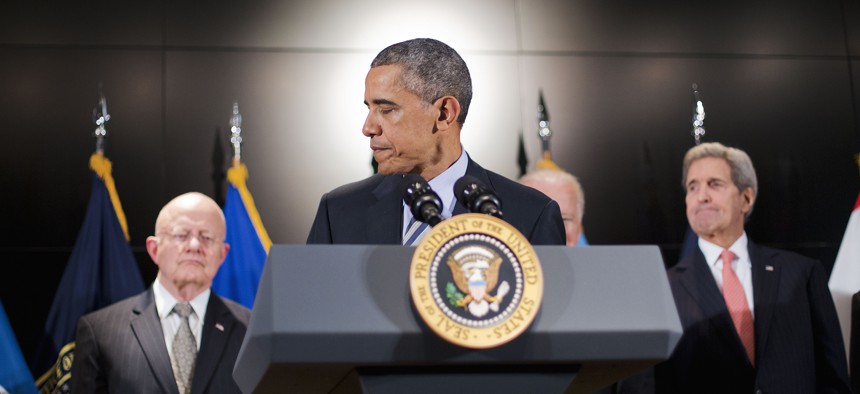
President Barack Obama, accompanied by, from left, Office of National Intelligence Director James Clapper, VP Joe Biden, and State Secretary John Kerry, ends his remarks at the National Counterterrorism Center in McLean, Va., Dec. 17, 2015. Pablo Martinez Monsivais/AP
The Intelligence Community Must Remove Barriers to Minority Recruitment
National security demands a more diverse workforce to understand the world, but several things stand in the way.
To properly understand a wide world of actors and adversaries, the U.S. intelligence community needs a diverse workforce. The good news is that the IC understands this; the bad news is it’s still largely white and male. It’s time to pay more attention to the various barriers that keep members of some key demographics from joining up.
According to the current human capital strategic plan from the Office of the Director of National Intelligence (ODNI), the employees of the 17 agencies that make up the U.S. intelligence community are predominantly white (76.6 percent) and male (61.6 percent). For reference, the U.S. population is currently 65.1 percent white and 49.3 percent male.
Most minorities are underrepresented in the intelligence workforce, if only slightly. For most demographics, the differences are under 1 percent between their share of the U.S. population and the IC’s workforce. Hispanics, however, are significantly underrepresented. In 2011, they accounted for 5.2 percent of the intelligence workforce, yet they made up 16.4 percent of the U.S. population.
That means the IC has some catching up to do lest it fall even further behind. The Census Bureau projects that the U.S. population will become majority-minority by 2044, with the Hispanic share expected to reach 29 percent by 2060.
But it’s trying. Since the establishment of the ODNI in 2005, the intelligence community has been relatively active in trying to fix this. The current ODNI human capital plan, which covers 2012-17, aims to create “a diverse, highly-skilled intelligence workforce that reflects the strength of America.” Since 2009, an Equal Employment Opportunity and Diversity Office has analyzed workforce data, identified barriers to diversity, and developed outreach and recruitment strategies to “draw from all segments of society.” These efforts, and the improvements they aim for, are regularly measured.
In 2005, following a congressional mandate to increase the pool of job applicants who are culturally and ethnically diverse, the government launched the Intelligence Community Centers for Academic Excellence (IC CAE) program, which funds dozens of university programs. Most IC CAE grants have been awarded to Minority Serving Institutions. However, graduating from an IC CAE does not guarantee a job in the Intelligence Community, and the extent to which these programs have been able to nurture diversity in the intelligence workforce remains unclear.
Minority students face numerous obstacles when seeking employment in the IC. There are no clear metrics on these challenges, but our experience as faculty members at an IC CAE program along the Southwest border is illustrative.
Close to four-fifths of the students enrolled at the University of Texas at El Paso, where we work, are Hispanic. About half are first-generation college students; many grew up in families whose first language is Spanish. Many take on jobs to finance their studies and support their families. As former CIA Deputy Director for Intelligence Carmen Medina notes, these conditions constitute barriers for employment given the demanding academic requirements set up by the Intelligence Community.
Even students who excel academically must obtain a security clearance, and that is made harder when family members live across the border, in Ciudad Juarez and beyond. Strong international ties can raise red flags during the stringent security vetting procedures, especially when those ties are to a region of the world noted in recent years for drug-related violence and corruption.
This all means that our students possess backgrounds and experiences and linguistic skills that simultaneously offer great potential value to the IC—and keep the IC from hiring them.
If senior government officials are serious about improving the diversity of the intelligence community’s workforce – and they should be – they must more proactively manage diversity, along with its perceived risks. A good first step is to overhaul the current background investigation process which has not evolved much since the 1950s. Recruitment also needs to better take into account the personal histories of minority applicants to give them a chance to explain less than perfect academic achievements. These steps won’t be easy to take but they are necessary to recruit a 21st-century intelligence workforce.



